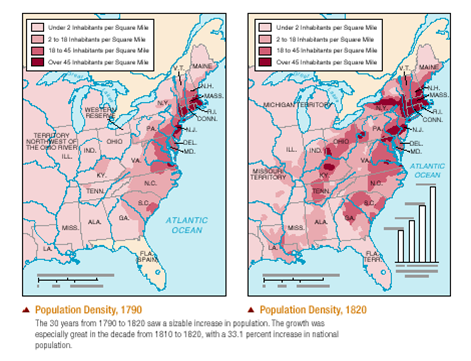Nascent Nationalism and Post War Expansion [1815 to 1825]
The War of 1812 stimulated America’s economic growth and gave birth to the
“American System,” promoting specialization and inter regional dependency.
What So Proudly We Hailed Review


Geographic Growth and Western Expansion Maintaining sectional balance is the primary goal
Between 1812-1819 six new states added to the Union:
Louisiana (1812)
Indiana (1816)
Mississippi (1817)
Illinois (1818)
Alabama (1819)
Maine (1820)
1800-1820: United States population grows from 5.3 million to 9.6 million in 20 years.
American families with 4 or 5 children were common place, families with 8 children were no unusual. Families with as many as 20 children could be found. Children in America were more likely to survive childhood. By the 1830's 1/3 of all Americans were under the age of 10 years old.
Politicians Henry Clay (11 children) and John Calhoun (10 children) represented the typical American family in the early 1800's
In total, the population would grow 1/3 every 10 years and double every 23 years. By comparison it took from 1930 to 1990 for the population to double.
Revolutions, unemployment, food shortages led many to emigrate to the United States:
Immigration #'s 1820's 150,000 1830's 600,000 1840's 1.5 million
Why the Internal Migration?
Plenty of cheap land out west while land prices in the East were steadily rising.

The Embargo Act (1807-09) pushed people west looking for new opportunities.
The Transportation revolution - roads, turnpikes and canals. Case Study: Cumberland Road (1811)
Successful victories over Indians alliances led to increased white migration west.
By 1820 25% of the population lived in the west
Economic Impact of Government Land Sales
….The Land Act of 1820 reduced the number of acres … from 160 to eighty and the cost from $2.00 per acre to $1.25 per acre, in an attempt to encourage additional land sales…. Additionally, Congress extended credit to the buyer for eight more years. The government hoped that with the time extension, the economy would improve. Farmers would then be able to sell their crops and make payments on their loans... People could often afford a smaller acreage, but not the 160 acres originally mandated by the Land Act of 1804. Overall, the federal government's policies were successful…
Henry Clay and the American System
A program of vigorous economic nationalism dependent on active government becomes Henry Clay's greatest contribution to national policy. Clay argued strongly for the development of a home market for domestic goods so Americans would not be dependent on foreign imports
Wedding of the Waters: The Erie Canal and the Making of a Great Nation [1817-1825] The building of the Erie Canal, like the construction of the Brooklyn Bridge and the Panama Canal, embodies one of the greatest and most riveting stories of American ingenuity.

The American System: Henry Clay vs. Andrew Jackson
https://youtu.be/PzZG6zV881g
The Belles of New England: The Women of the Textile Mills
The New England's textile mills were experiments in benevolent enlightened social responsibility that had an enormous cultural and economic impact on America.
The Panic of 1819
First financial since at the “Critical Period (1780’s) under the Articles of Confederation – Cyclic panics and depressions will occur every 20 years
https://history.howstuffworks.com/historical-events/5-financial-panics2.htm
The Presidency of James Monroe
A program of vigorous economic nationalism dependent on active
Comments (0)
You don't have permission to comment on this page.